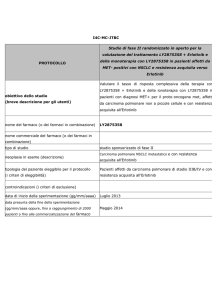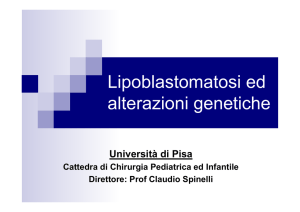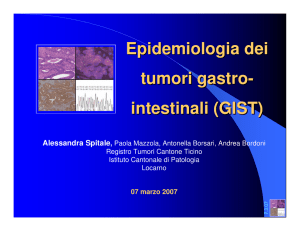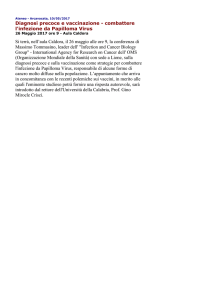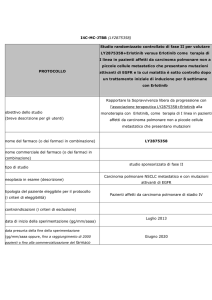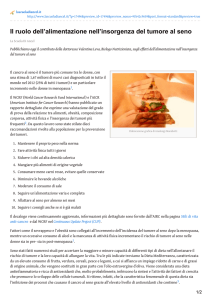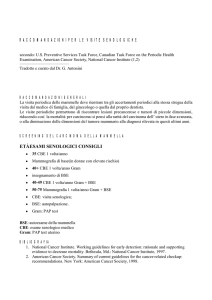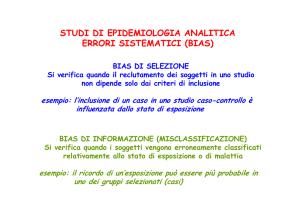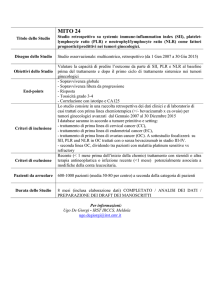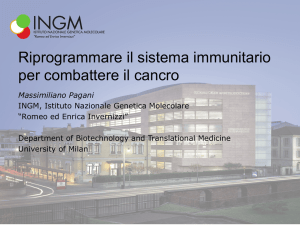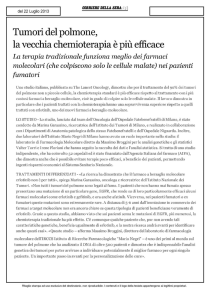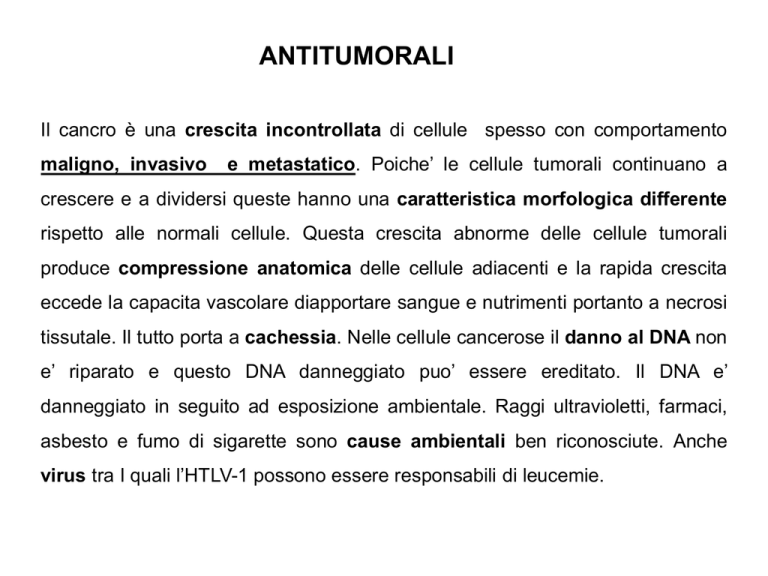
ANTITUMORALI
Il cancro è una crescita incontrollata di cellule spesso con comportamento
maligno, invasivo
e metastatico. Poiche’ le cellule tumorali continuano a
crescere e a dividersi queste hanno una caratteristica morfologica differente
rispetto alle normali cellule. Questa crescita abnorme delle cellule tumorali
produce compressione anatomica delle cellule adiacenti e la rapida crescita
eccede la capacita vascolare diapportare sangue e nutrimenti portanto a necrosi
tissutale. Il tutto porta a cachessia. Nelle cellule cancerose il danno al DNA non
e’ riparato e questo DNA danneggiato puo’ essere ereditato. Il DNA e’
danneggiato in seguito ad esposizione ambientale. Raggi ultravioletti, farmaci,
asbesto e fumo di sigarette sono cause ambientali ben riconosciute. Anche
virus tra I quali l’HTLV-1 possono essere responsabili di leucemie.
Pathogenesis of Neoplasia :
Cancer development can begin with a brief exposure (hours
or days) to a chemical into an activated form and the
chemical need not be present ever again.
However, DNA is altered via mutagens including chemical
carcinogens, viruses, and radiation. This mutations is
inherted by at least one cell division (intiation).
This mutation mainly lead to activation of proto-oncogene
into oncogenes (leading to uncontrolled cell proliferation)
and/or inactivation of tumor suppressor genes (leading to
resistance to apoptosis.)
Upon exposure to other epigenetic factors (hormones, cocarcinogens, immunosuppressant…which themselves are
non carcinogenic) tumor growth is promoted (promotion).
Gli effetti degli antitumorali sono perciò anche su cellule non
tumorali ed impediscono perciò la crescita dei peli (capelli) e
dell’epitelio intestinale.
I tumori ad alto frazione di crescita come la leucemia mieloide
acuta, linfomi di Hodgkin’s sono i più sensibili ai chemioterapici.
Un problema dei chemioterapici è nei confronti dei tumori solidi in
quanto non riescono a raggiungere il centro del tumore. Soluzioni a
questo problema sono la radioterapia o la chirurgia.
Una terapia combinata tra chemioterapia e radioterapia è una
soluzione al problema.
La terapia adiuvante, detta anche chemioterapia pre e post chirurgica ha lo scopo di ridurre la massa tumorale prima
dell’intervento rendendo così la terapia locale (chirurgia e
radioterapia) meno distruttiva e più efficace.
Per chemioterapia palliativa si intende quella cura che ha lo scopo
di ridurre la massa tumorale aumentando l’aspettativa di vita.
CLASSI DI FARMACI ANTITUMORALI
1) Agenti alchilanti
2) Antimetaboliti
3) Antimitotici
4) Alcaloidi di origine vegetale
5) Antibiotici antitumorali
6) Inibitori Topoisomerasi
7) Anticorpi monoclonali
8) Inibitori dei fattori di crescita
AGENTI ALCHILANTI
A) Alchil sulfonati (busulfano)
B) Nitrosouree (Carmustina, Lomustina)
C) Mostarde azotate ( Ciclofosfamide, Mecloretamina, uramustina,
Melphalan, clorambucile, ifosfamide)
D) Composti del Platino (Cis-platino, Carboplatino, Oxaliplatino)
E) Idrazine (Procarbazina)
F) Tiazine (Dacarbazina)
G) Aziridine (Tiotepa)
Nitrosuree
1) Carmustina
2) Streptozocina
Lomustina
Imidazotetrazine
Temozolimide
Mostarde azotate
Mecloretamina
Cyclophosphamide
Melphalan
Clorambucile
Composti antitumorali del platino
1) Cisplatino
2) Carboplatino
3) Oxaliplatino
4) Tetranitrato triplatino
Idrazine
Procarbazina
Tiazine
Dacarbazina
Aziridine
Tiotepa
La dacarbazina è un agente alchilante usata nel melanoma maligno, nel
linfoma di Hodgkin, nei sarcomi e nei carcinomi del pancreas
Meccanismo di azione degli agenti alchilanti
Gli agenti alchilanti si legano con molte molecole intracellulari tra cui gli acidi
nucleici impedendone la lettura e quindi la trascrizione. La citotossicità è
primariamente dovuta al legame crociato tra filamenti di DNA ed RNA così
come all’inibizione della sintesi proteica.
Problems associated with chemotherapy
Resistance to chemotherapy
Resistance to chemotherapy may develop by several
mechanisms:
Decrease in the amount of drug uptake by cancer cells
Esempio: Methotrexate
Increase in the amount of drug removed by cancer
cells. (Transporters=P-glycoprotein).
Esempio: Vinblastine ,doxorubicin, bleomycin ,etapsoid….
Decrease or alteration in target molecule sensitivity –
this is caused by mutation in the molecule targeted by
the drug
Esempio: Methotrexate,Mercaptopurine,doxorubicin
Increase in DNA repair ability of the cell via an
increased expression of DNA repairing enzymes.
Esempio: Alkylating agent
Il busulfano è il solo agente usato nei regimi di mielosoppressione nei trapianti
di cellule staminali ematopoietiche per la quale il monitoraggio terapeutico del
farmaco è largamente usato. L’uso di busulfano per via orale porta ad una grande
variabilità intrapaziente e interpaziente in termini farmacocinetici specialmente nei
bambini e l’aggiustamento delle dosi è necessario per una ridotta tossicità e migliore
riuscita terapeutica. L’uso di busulfano per via endovenosa sta prendendo piede in
quando porta a dei profili farmacocinetici più controllabili.
La meningite neoplasica rappresenta il 5% dei tumori. E’ una malattia che colpisce
l’intero neuroasse e i farmaci devono passare nel fluido cefalorachidiano.
Oggigiorno la terapia con farmaci direttamente immessi nel liquido cefalorachidiano
è ristretta a tre farmaci: Il metotressato, la citarabina ed il tiotepa.
Il cis-platino è un antitumorale usato per trattare vari tipi di cancro tipo sarcoma,
carcinosarcomi (piccolo cellule del polmone, cancro ovarico), linfomi. E’ il primo di
una classe che va in crescendo di nuovi composti quali il carboplatino, l’oxaliplatino.
Questi composti formano dei complessi all’interno della cellula tumorale i quali
legano il DNA attraverso legami intracatena e tra catene di DNA. A questo segue
l’apoptosi cellulare.
Although the entity we refer today as chronic myeloid leukemia (CML) was probably first
described in the early nineteenth century, there was little progress in understanding its
biology until the discovery of the Philadelphia (Ph) chromosome in 1960.1 Subsequent
important landmarks were the recognition that the Ph chromosome results from a t(9;22)
translocation, the demonstration that the leukemia probably originates from a single
hematopoietic “stem cell,” the identification of the breakpoint cluster region (BCR) on
chromosome no. 22 and subsequently of the BCR-ABL fusion gene, and more recently the
development of a murine model simulating the human disease.2,3 Treatment in the 19th
century was unsatisfactory, although arsenicals induced some degree of symptomatic
control. In the early 20th century, radiotherapy was helpful, but it was replaced in the
1950s by busulfan, which remained popular for some years, despite the emerging
suspicion that this alkylating agent might in fact predispose to progression to advancedphase disease. In due course, hydroxycarbamide replaced busulfan, but interferon-alfa,
the first agent to induce any degree of Ph-chromosome negativity in the bone marrow, was
introduced in the early 1980s and became the treatment of choice for patients not eligible for
allogeneic stem cell transplantation. Between 1980 and 2000, allografting, despite the risks
of morbidity and mortality, was the recommended initial treatment for younger patients with
HLA-matched donors. Therapy has now been “revolutionized” by the introduction of
imatinib (imatinib mesylate, IM), the original Abl tyrosine kinase inhibitor (TKI), which
was used first in the clinic in 1998.
(Blood. 2007;110:2828-2837)
L’osteosarcoma è un cancro a carico dell’osso e generalmente
colpisce le ossa grandi delle braccia e delle gambe. E’ presente
frequentemente in giovani e sopratutto nei maschi.
La prognosi dell’ osteosarcoma degli arti trattata con solo
amputazione può essere migliorata drammaticamente includendo
la chemioterapia. La chemioterapia neoadiuvante è comunemente
usata per eradicare le micrometastasi e per preparare gli arti alla
chirurgia di salvataggio.
Oggi giorno una chirurgia conservativa è possibile nella maggior
parte dei pazienti incluso i bambini ed è anche libera da recidive
nei casi di sopravvivenza nel 50-80%. Alte dosi di metotressato,
doxorubicina, cis-platino ed ifosfamide sono considerate i
farmaci più attivi contro l’osteosarcoma.
Bull Cancer. 2006 Nov 1;93(11):1115-20.
HODGKIN
Definizione del linfoma di Hodgkin: Un cancro del sistema immunitario
nel quale si evidenzia la presenza di un tipo particolare di cellule dette
Reed-Sternberg cell. I due tipi principali di linfoma di Hodgkin sono il
classico e il nodulare che rappresenta il principale. I sintomi includono
dolore e ingrossamento dei linfonodi, della milza o altri tessuti immunitari.
Altri sintomi includono febbre, perdita di peso fatica e sudorazione
notturna.
Definizione di linfoma non-Hodgkin: Rappresenta una versione di cancro al
sistema immunitario (linfociti). Il linfoma non-Hodgkin è presente a qualsiasi età e
spesso è caratterizzato da ingrossamento dei linfonodi, febbre e perdita di peso. Ci
sono diversi tipi di linfoma non-Hodgkin i quali possono essere suddivisi in
aggressive (a crescita veloce) e indolenti ( a crescita lenta e possono essere
classificati in linfomi delle cellule B o delle cellule T .
Tra i linfomi delle cellule B ricordiamo il linfoma di Burkitt , linfomi diffusi delle cellule
B, linfomi follicolari, linfomi immunoblastici a cellule grandi, linfomi di precursori delle
cellule B e linfomi di cellule mantello. Linfomi non-Hodgkin delle cellule T includono
micosi funginee, linfomi anaplastici a cellule grandi e linfomi di precursori delle
cellule T. Linfomi correlati a disordini linfoproliferativi presenti a seguito di trapianti di
midollo osseo o di cellule staminali generalmente sono linfomi non-hodgkin di cellule
B.
Reed-Sternberg cell
ANTIMETABOLITI
1) Analoghi dell’acido folico
2) Analoghi delle purine
3) Analoghi delle pirimidine
Analoghi dell’acido folico
Analoghi dell’acido folico
METOTREXATO:
Il metotrexato è un analogo dell’acido folico e inibisce la
diidrofolico reduttasi prevenendo la formazione dell’acido
tetraidrofolico. Questo acido è essenziale per la formazione
delle purine e pirimidine componenti del DNA ed RNA. Il
tetraidofolato è coinvolto anche nella sintesi di aminoacidi
quali serina e metionina.
La sua tossicità è a carico di cellule ad alta velocità di
duplicazione quali quelle del midollo, della pelle e dei capelli.
Leuk Lymphoma. 2011 Oct;52(10):1882-90. Epub 2011 Jun 12.
High-dose methotrexate based chemotherapy with deferred radiation for
treatment of newly diagnosed primary central nervous system lymphoma.
Gerard LM, Imrie KR, Mangel J, Buckstein R, Doherty M, Mackenzie R, Cheung
MC.
Odette Cancer Centre, Sunnybrook Health Sciences Centre, Toronto, Ontario,
Canada.
Abstract
The addition of high-dose methotrexate (HD-MTX) to whole-brain
radiation therapy (WBRT) has improved the survival of patients with
primary central nervous system lymphoma (PCNSL). However,
combined therapy is associated with increased neurotoxicity. In an effort
to limit this toxicity, we treated a series of non-immunocompromised
patients with HDMVP, a HD-MTX based regimen, with deferral of WBRT
until progression. Twenty-three patients were treated with the HDMVP
regimen consisting of MTX, vincristine, and procarbazine.
The mean age at diagnosis was 60.9 years (range 45-79 years). The
overall response rate was 65% (14 complete responses and one partial
response).
Prog Urol. 2011 Jun;21(6):369-82.
The role of chemotherapy in the management of bladder
cancer.
Département d'oncologie médicale, France. [email protected]
Abstract
Bladder cancer represents for man the second
genitourinary cancer after prostate cancer. Urothelial
carcinoma is the most predominant histological type. In up to
70% of the cases, the diagnosis of bladder cancer is
performed at early stages (Ta-T1). In this situation, the
treatment of the disease is the transurethral resection with or
without intravesical treatment (BCG, Amiticyne). In
advanced disease, treatment is essentially palliative with
chemotherapy based on cisplatin type MVAC (methotrexate,
vinblastine, doxorubicin, and cisplatin) or gemcitabinecisplatin. In invasive stages (T2-T3-T4), the radical
cystoprostatectomy combined with urinary diversion for man,
and the pelvectomy for woman are the gold standard.
Metotrexato nell’artrite reumatoide
www.thelancet.com Vol 376 September 25, 2010
Analoghi delle Purine
Appartengono a questa categoria:
1) Azatioprina è la principale di questa classe. E’ largamente utilizzata come
immunosoppressivo nei trapianti d’organo prevenendo la moltiplicazione
linfocitaria nella fase di induzione del sistema immunitario. Interferisce sia attraverso
l’inibizione della risposta immunitaria mediata dai linfociti che da quella umurale . E’
metabolizzata in 6-mercaptopurinea che agisce come analogo delle purine ed
inibitore della sintesi del DNA. E’ usata in caso di autoimmunità
2) Mercaptopurina
3) Tioguanina è usata nelle leucemie acute
4) Fludarabina inibisce la DNA polimerasi, la DNA primasi e ligasi I ed è
fase specifica.
Oncotarget. 2010 Nov;1(7):472-82.
Refractory chronic lymphocytic leukemia--new therapeutic strategies.
Schnaiter A, Stilgenbauer S.
University of Ulm, Ulm, Germany.
Abstract
Treatment outcome of chronic lymphocytic leukemia (CLL) has
considerably improved since the introduction of fludarabine (F) as part of
the standard therapy.
Nevertheless, refractoriness to fludarabine occurs in a significant number
of patients and is associated with an unfavorable prognosis. Important risk
factors are 17p deletion and/or mutation of TP53. For this subgroup the
CD52 antibody alemtuzumab (A) presents a new treatment approach and
has already been approved. Meanwhile we have to face also
refractoriness to alemtuzumab. Importantly, the monoclonal CD20 antibody
ofatumumab has now shown efficacy in F and A double-refractory CLL.
The next generation CD20 antibody GA-101 is currently compared to
rituximab (R) and will possibly be its more potent successor. Further B-cell
antigens are targeted by lumiliximab (CD23), TRU-016 (CD37) and
blinatumomab (CD19).
Analoghi delle Pirimidine
Appartengono a questa categoria:
1) 5-fluorouracil inibisce la timidilato sintetasi inibendo la metilazione
dell’acido desossiuridilico ad acido timidilico e quindi interferendo con
la sintesi di DNA.
2) Floxuridine
3) Cytosine arabinoside
BJU Int. 2011 Jul;108(2):168-79. doi: 10.1111/j.1464-410X.2011.10341.x.
Gemcitabine chemotherapy for the treatment of metastatic bladder
carcinoma.
Shelley MD, Cleves A, Wilt TJ, Mason MD.
Cochrane Urological Cancers Unit, Velindre NHS Trust Cardiff, Cardiff, UK. [email protected]
Abstract
OBJECTIVE:
• To systematically review the literature on gemcitabine chemotherapy for
advanced or metastatic bladder cancer.
CONCLUSIONS:
• Gemcitabine combined chemotherapy is active in the management
of metastatic bladder cancer.
• Gemcitabine may be considered an alternative regime to MVAC.
• Gemcitabine Carboplatin should be considered for patients unfit for
cisplatin-based therapy.
ANTIMITOTICI
Sito di azione degli
A questa categoria appartengono: antimitotici
1) Tassani
2) Alcaloidi della Vinca
Paclitaxel
Vincristine
Meccanismo di Azione
Il Paclitaxel è un inibitore della mitosi cellulare usato in chemioterapia. E’
stato scoperto nel 1967 quando venne isolato da un albero secolare del
pacifico il Taxus brevifolia ed è stato sviluppato commercialmente dalla
Bristol-Myers Squibb (BMS) con il nome di paclitaxel.
Il paclitaxel interferisce con la normale rottura dei microtubuli
stabilizzando queste strutture.
Viene distrutta perciò la capacità cellulare di usare il citoscheletro in
maniera flessibile legandosi alla subunità beta della tubulina, che
costituisce l’unità funzionale dei microtubuli, stabilizzando l’intera
struttura.
microtuboli
I microtubuli
•
Sono organuli citoplasmatici presenti in tutte le
cellule. Appaiono al M.E. come strutture cilindriche
cave, con un diametro di 25 nm ed uno interno di 15
nm.
• In sezione longitudinale i microtubuli appaiono come
bastoncini di lunghezza variabile che può
raggiungere 20-60 μm.
• La parete dei microtubuli è composta da una serie di
unità sferoidali ordinate rigidamente di 4 nm. Ogni
subunità corrisponde ad una molecola di tubulina.
Citologia BCM /BU
I microtubuli
• La tubulina è un dimero di p.m. 110.000,
formato da due subunità di sequenza
amminoacidica simile, chiamate tubulina
α e tubulina ß.
• I dimeri di tubulina polimerizzano a
formare lunghe catene chiamate
protofilamenti.
• Nella cellula i protofilamenti sono
assemblati a gruppi di tredici in una
struttura che nel complesso forma il
microtubulo.
• I protofilamenti si avvolgono a spirale di
passo sinistrorso e decorrono paralleli tra
di loro intorno all'asse del microtubulo
Il Paclitaxel è utilizzato per trattare pazienti con:
Cancro al polmone
Cancro alle ovaie
Cancro della mammella,
Sarcoma di Kaposi
Il sarcoma di caposi è caratterizzato da una crescita anormale dei vasi
sanguigni che producono lesioni cutanee che possono avvenire anche
internamente.
Il Paclitaxel è usato anche nel prevenire la ristenosi.
Lancet. 2009 Oct 17;374(9698):1371-82. Epub 2009 Sep 28.
Ovarian cancer.
Hennessy BT, Coleman RL, Markman M.
Department of Gynecologic Medical Oncology, University of Texas MD Anderson
Cancer Center, Houston, TX 77030, USA.
Abstract
The standard initial management of epithelial ovarian cancer consists of surgical
staging, operative tumour debulking including total abdominal hysterectomy and
bilateral salpingo-oophorectomy, and administration of six cycles of intravenous
chemotherapy with carboplatin and paclitaxel.
Extensive and largely retrospective experience has shown that optimum surgical
debulking to leave residual tumour deposits that are less than 1 cm in size is
associated with improved patient outcomes. However, 75% of patients present with
advanced (stage III or IV) disease and, although more than 80% of these women
benefit from first-line therapy, tumour recurrence occurs in almost all these patients at
a median of 15 months from diagnosis. Second-line treatments can improve survival
and quality of life but are not curative. Advances in screening and understanding of
molecular pathogenesis of ovarian cancer and development of novel targeted
therapies (eg, bevacizumab) and practical intraperitoneal techniques for drug
delivery are most likely to improve patient outcomes.
Effetti collaterali del PACLITAXEL
I più comuni effetti collaterali sono nausea e vomito,
perdita dell’appetito cambiamento del gusto, dolore
delle articolazioni che dura diversi giorni, formicolio
alle estremità.
Effetti collaterali più gravi sono: sanguinamento nel
sito di iniezione, febbre, tosse, respiro affannato.
ALCALOIDI DI ORIGINE VEGETALE
Gli alcaloidi della vinca sono : Vincristina,
Vinblastina
La vincristina è un alcaloide della
Catharanthus roseus, originariamente
chiamata Vinca rosea. E’ un inibitore della
mitosi cellulare ed è usata nella
chemioterapia.
Meccanismo di Azione
La tubulina è una proteina strutturale che polimerizza
formando i microtubuli. Il citoscheletro è costituito da
microtubuli. La vincristina lega i dimeri di tubulina
inibendo l’assemblaggio strutturale di questi arrestando la
mitosi in metafase. Gli alcaloidi della vinca perciò
agiscono rapidamente in cellule che si dividono quali
quelle cancerose ma anche in quelle dell’epitelio
intestinale e midollari.
CA Cancer J Clin. 2010 Nov-Dec;60(6):393-408. Epub 2010 Oct 28.
Improving outcomes for patients with diffuse large B-cell lymphoma.
Flowers CR, Sinha R, Vose JM.
Bone Marrow and Stem Cell Transplantation, Department of Hematology and Oncology, Winship Cancer
Institute, Emory University School of Medicine, Atlanta, GA 30322, USA.
[email protected]
Abstract
Diffuse large B-cell lymphoma (DLBCL) is the most commonly occurring form of nonHodgkin lymphoma in the western world. Until the mid 1990s the incidence of DLBCL
increased in both sexes, across racial categories, and across all age groups except
the very young, the etiology of most cases remains unknown. DLBCL is associated
with an aggressive natural history, but it can be cured with combination chemotherapy
regimens like cyclophosphamide, doxorubicin, vincristine, and prednisone
(CHOP), which has been the mainstay of therapy for several decades. Remarkable
progress has been made in understanding the biological heterogeneity of DLBCL and
in improving survival for DLBCL patients with novel combinations of chemotherapy and
immunotherapy. Gene expression profiling (GEP) has uncovered DLBCL subtypes that
have distinct clinical behaviors and prognoses, and the addition of the monoclonal
antibody, rituximab, to CHOP has markedly improved outcomes. Future approaches to
DLBCL management will use molecular signatures identified through GEP to provide
prognostic information and to isolate therapeutic targets that are being evaluated for
DLBCL patients who relapse or those with high risk disease.
ANTIBIOTICI ANTITUMORALI
Tra gli antibiotici antitumorali sono di tre classi:
1) Antracicline (Doxorubicina conosciuta anche come Adriamicina)
2) Antracenedioni (Mitoxantrone)
3) Streptomicine (Actinomicina, Bleomicina, Mitomicina)
Meccanismo di Azione
L’esatto meccanismo dell’ azione antitumorale della doxorubicina è complesso
e ancora non ben conosciuto. Comunque si pensa che possa intercalarsi nel
DNA inibendo la topoisomerasi II la quale apre il DNA per la trascrizione.
Uso clinico
La doxorubicina è comunemente usata per trattare la
leucemia, il linfoma di Hodgkin, cancro alla vescica, alla
mammella, allo stomaco, ai polmoni alle ovaie, alla tiroide,
nel sarcoma di tessuti molli etc.
I regimi classici con la doxorubicina sono :
1) Doxorubicina + ciclofosfamide + adriamicina
2) Adriamicina + bleomicina + vinblastina + dacarbazide
3) 5-fluorouracile + adriamicina + ciclofosfamide
Expert Rev Anticancer Ther. 2008 Dec;8(12):1859-69.
Efficacy and toxicity of nonpegylated
liposomal doxorubicin in breast cancer.
Stavridi F, Palmieri C.
Department of Medical Oncology, St George's Hospital, Blackshaw Road, London,
SW18 0QT, UK.
Abstract
Anthracyclines, including doxorubicin, are the mainstay of
therapy for breast cancer. However, doxorubicin can cause
dose-dependent cardiotoxicity, limiting the cumulative dose.
Liposomal conjugation of doxorubicin results in preferential
distribution of doxorubicin in the tumor compared with normal
tissues. Non-pegylated liposomal doxorubicin (NPLD) has
demonstrated reduced cardiac toxicity, with anti-tumor
responses comparable to those of conventional doxorubicin.
The substitution of NPLD for conventional anthracyclines
significantly reduces the cumulative cardiotoxicity, while allowing
a higher cumulative dose.
Tumori. 2009 Jul-Aug;95(4):422-6.
Non-pegylated liposomal doxorubicin in combination with
cyclophosphamide or docetaxel as first-line therapy in metastatic breast
cancer: a retrospective analysis.
Livi L, Meattini I, Cardillo Cde L, Mangoni M, Greto D, Petrucci A, Rampini A, Bruni A, Galardi A, Cataliotti L, Biti G.
Abstract
AIMS AND BACKGROUND:
Anthracyclines such as doxorubicin play a central role in the
management of advanced breast cancer. Unfortunately, the clinical benefits
of anthracyclines are limited by cardiotoxicity that can lead to the
development of potentially fatal congestive heart failure. In order to limit
anthracycline-related cardiotoxicity, liposomal formulations of doxorubicin have
been developed. This retrospective analysis evaluated the experience obtained
with non-pegylated liposomal doxorubicin as first-line therapy in 34 patients
with metastatic breast cancer.
CONCLUSIONS:
Our results support the use of non-pegylated liposomal doxorubicin as
an alternative to conventional doxorubicin formulations in combination
regimens for the first-line therapy of metastatic breast cancer.
INIBITORI DELLE TOPOISOMERASI
1) Camptotecine (Topotecano e irinotecano)
2) Podofillotossine (Etoposide)
La camptotecina è un alcaloide citotossico il
quale inibisce la topoisomerasi I. E’ stata
scoperta nel 1966 dalla corteccia di un albero, la
Camptotheca acuminata nativo della Cina. Ha
una bassa solubilità percui i chimici farmaceutici
hanno prodotto due nuove molecole analoghe
della camptotecina e più solubili quali il
topotecano e l’irinotecano.
A) La Topoisomerases I si lega alla
doppia elica del DNA e si lega in modo
covalente al terminale 3’ della rottura
della catena. Tutte le altre
topoisomerasi si legano alla porzione 5’
della catena rotta del DNA. Questi
complessi sono stabilizzati
selettivamente dalla camptotecina.
B) Sito catalitico della topoisomerasi I.
Residuo catalitico della tirosina porta
l’attacco nucleofilico e rottura del
legame estere fosforico presente nel
DNA.
The clinical effectiveness and cost-effectiveness of
topotecan for small cell lung cancer: a systematic
review and economic evaluation
E Loveman,* J Jones, D Hartwell, A Bird, P Harris, K Welch and A Clegg
Southampton Health Technology Assessments Centre (SHTAC), UK
Conclusions: Topotecan appeared to be better than Best Supporting Care
alone in terms of improved survival, and was as effective as CAV
[cyclophosphamide, Adriamycin (doxorubicin) and vincristine] and less
favourable than i.v. amrubicin in terms of response.
Oral topotecan and i.v. topotecan were similar in efficacy. Topotecan offers
additional benefit over BSC, but at increased cost. ICERs for i.v. topotecan,
compared with BSC, were high and suggest that it is unlikely to be a cost-effective
option.
The ICER for oral topotecan is at the upper extreme of the range conventionally
regarded as cost-effective from an NHS decision-making perspective. Further
research into the QoL of patients with relapsed small cell lung cancer (SCLC) could
identify the impacts of disease progression and treatment response.
ANTICORPI MONOCLONALI
Sono una classe di farmaci in grande sviluppo nella terapia
antitumorale. Sono molto specifici in quanto di legano ad anticorpi
presenti sulle membrane cellulari di cellule tumorali.
Il trastuzumab è un anticorpo monoclonale umanizzato che agisce al
recettore Her 2. Questo tipo di recettore è altamente espresso nel tumore
della mammella. E’ somministrato una volta alla settimana o ogni tre
settimane per infusione endovenosa per 30-90 minuti.
Alemtuzumab It is used to treat patients with chronic lymphocytic leukaemia
(CLL), a cancer of the lymphocytes
Nomenclatura degli anticorpi monoclonali in terapia
1) Murine (muro-........ab) (100% di origine di topo)
Es: Muromonab
2) Chimeric (-ximab) (33% di origine di topo)
Es: Rituximab
3) Humanized (-xumab; -zumab) (5-10% di origine di topo)
Es:Alemtuzumab
4) Human (-mumab) (0% di origine di topo)
Es:Adalimumab
Struttura di un anticorpo
Struttura degli anticorpi
La famiglia delle immunoglobuline
The first type of antibody classification is Immunoglobulin A (IgA) which protects
mucosal surfaces with a fluid like secretion (Vedhara & Irwin, 2005). IgA is found in
serum, mucus, saliva, tears, sweat, and milk and has also been associated with being
transferred to an unborn child (passive immunity) and can also protect the child after birth for
several months. This time frame can be further increased when the mother breast-feeds (
Niers, Stasse-Wolthuis, Rombouts, & Rijkers, 2007).
A second type of antibody classification is Immunoglobulin E (IgE) which triggers the
release of histamines by attaching to antigens, basophils, and mast cells ( Vedhara &
Irwin, 2005). IgE does not make up a very large portion of antigens but it is responsible for
reactions resulting in hives, asthma, and hayfever as examples (Paustian & Roberts, 2005).
A third type of antibody classification is Immunoglobulin M (IgM) which forms
antibody-antigens processed by the liver and stimulates complement-mediated lysis
(Vedhara & Irwin, 2005). IgM makes up about 10% of the total antibodies and it is very
important in the initial phases of an illness to stop the spreading of the pathogen ( Paustian &
Roberts, 2005).
A fourth type of antibody classification is Immunoglobulin G (IgG) which allows for the
consumption of pathogens such as bacteria by coating them so that macrophages
and neutrophils will be able to recognize them as pathogens (Vedhara & Irwin, 2005).
IgG is the largest classification of circulating antibodies ( Paustian & Roberts, 2005).
The fifth type of antibody classification is Immunoglobulin D (IgD) which is lacking in
enough research to clearly understand its functions (Vedhara & Irwin, 2005). This
antibody located on the surface of B-lymphocytes (Paustian & Roberts, 2005). Currently
there are research studies being conducted on immature IgD antibodies to transfer them to
becoming mature B cells in an effort to try and gain further understanding of the actual
function IgD antibodies (Koelsch et al., 2007).
Am J Transl Res 2011;3(3):269-274
Her/neu
L’HER2/neu (conosciuto anche come ErbB-2) sta ad indicare "Human
Epidermal growth factor Receptor 2" ed è una proteina ad alta aggressività nel
cancro della mammella. E’ un membro della famiglia proteica degli ErbB
conosciuta più come epidermal growth factor receptor family. HER2/neu è
anche conosciuta come CD340 (cluster of differentiation 340) e p185. E’
codificata nel gene ERBB2.
Cellule contenenti una forte sovraespressione di HER-2/neu mostrano una
migliore inibizione della crescita per effetto dei trattamenti chemioterapici
rispetto a quella ottenuta nei sistemi cellulari con più basso livello di
espressione.
The last decade has witnessed an increasing
number of biologic markers of breast
neoplasms. One of the markers with probable
prognostic significance is over-expression
of the HER-2/neu oncogene within the tumor.
Although HER-2/neu over-expression has been
shown to correlate with a poor prognosis in
invasive breast cancer, little information is
available on the relationship between its overexpression and the outcome of patients with
DCIS. Previous studies have
indeed demonstrated that HER-2/neu
expression correlates with aggressive histologic
features in DCIS, but the prognostic significance
of HER-2/neu expression in the clinical setting
has yet to be determined.
111In-Trastuzumab
Fab (111In-humAb4D5-8 Fab) is formed by the
conjugation of 111In via the bifunctional chelate, diethylenetriamine
pentaacetic acid (DTPA), with the Fab fragment of the recombinant
humanized monoclonal antibody (MAb) against the antigen of
human epidermal growth factor receptor 2 (HER2). 111InTrastuzumab Fab has been developed for imaging of human breast
cancer (1-3).
Meccanismo di Azione
L’aumento del numero dei recettore HER2/neu (ERB2) avviene nel
20-30% dei casi di tumore alla mammella nei primi stadi della
malattia. Questo recettore attiva intracellularmente una via molto
importante che è quella della PI3K/Akt. Questa via è associata ai
segnali di mitogenesi coinvolgendo la via della MAPKinasi. Nelle
cellule cancerose il recettore HER2/neu
sono trasmessi
costitutivamente promuovendo l’invasione la sopravvivenza e
l’angiogenesi
cellulare.
Le
cellule
trastuzumab si arrestano in fase G1.
tumorali
trattate
con
Meccanismo di Resistenza
Il primo meccanismo di resistenza è quello dovuto alla induzione di
p27kip1, un inibitore del cdk2 e della proliferazione cellulare che
rimane nel citoplasma invece di traslocare nel nucleo. Questo è
causato dalla fosforilazione della Akt.
Meta-analysis of all available studies based on 12 months of
trastuzumab showed that there was a statistically significant 30%
relative improvement in overall survival using the 3-weekly
regimen.
EFFETTI TOSSICI DEI FARMACI ANTITUMORALI
INIBITORI DEI FATTORI DI CRESCITA
A questa classe appartengono:
1a Generazione:
1) L’erlotinib
2) Gefitinib
2aGenerazione:
1) Nilotinib
Erlotinib
2) Dasatinib
L’Erlotinib è un farmaco usato nel trattamento del cancro al polmone a non
piccole cellule, cancro pancreatico e altri tipi di cancro.
Pharmgenomics Pers Med. 2013 Aug 5;6:57-62.
Bosutinib: a SRC-ABL tyrosine kinase inhibitor for treatment of chronic
myeloid leukemia.
Rassi FE, Khoury HJ.
Division of Hematology, Department of Hematology and Medical Oncology, the Winship Cancer Institute at Emory University,
Atlanta, Georgia, USA.
Abstract
Bosutinib is one of five tyrosine kinase inhibitors commercially available in the
United States for the treatment of chronic myeloid leukemia.
Bosutinib has shown considerable and sustained efficacy in chronic myeloid
leukemia, especially in the chronic phase, with resistance or intolerance to
prior tyrosine kinase inhibitors.
Bosutinib has distinct but manageable adverse events. In the absence of T315I and
V299L mutations, there are no absolute contraindications for the use of bosutinib in
this patient population.
Mutations
Mutations in the tyrosine kinase inhibitor binding site of
BCR/ABL is another important mechanism of drug resistance.
The kinase domain mutation frequency is 23% in naive CML
patients. 40-60% of CML patients under prolonged imatinib
exposure that have clinical resistance, harbour BCR-ABL
kinase domain mutations. Point mutations were observed in
approximately 35-70% of patients displaying imatinib
resistance, either spontaneously or through the evolutionary
pressure of imatinib. If mutations are detected prior to or
early after administration of imatinib treatment, they generally
predict the clinical imatinib-resistance and progression.
Walker A motif, also known as the Walker loop or P-loop (phosphate-binding loop)
is a motif in proteins. The motif has the pattern GXXXXGK(T/S), where G, K, T and
S denote glycine, lysine, threonine and serine residues respectively, and X denotes
any amino acid. It is an ATP or GTP binding motif found in many nucleotidebindingproteins.
Il fattore di crescita epiteliale
L’EGFR (epidermal growth factor receptor), il recettore per il fattore
di crescita epiteliale è presente sulla superficie cellulare . Per la
trasmissione del segnale due molecole di EGFR si debbono legare
formando un dimero. Attraverso l’uso di ATP questei due recettori si
fosforilano e questa autofosforilazione porta ad una modificazione
strutturale facendo partire tutta una cascata di eventi che portano
l’informazione a livello nucleare per la replicazione cellulare.
L’ HER2/neu (anche conosciuto come ErbB-2 che significa
Epidermal growth factor Receptor 2) è una proteina con alta
aggressività nel cancro della mammella. HER2/neu viene oggi
codificato come CD340 e p185.
Ras= Rat Sarcoma
Biochem Soc Trans. 2013 Aug;41(4):1042-7.
Regulation of Janus kinases by SOCS proteins.
Kershaw NJ, Murphy JM, Lucet IS, Nicola NA, Babon JJ.
Department of Biochemistry and Molecular Biology, Monash University, Clayton, VIC 3800, Australia.
Abstract
JAKs (Janus kinases) are essential mediators of almost all biological
signalling events initiated by haemopoietic and immune cytokines. However,
aberrant and/or prolonged JAK-induced signalling is detrimental and can give rise
to a number of inflammatory and proliferative pathologies.
For this reason, the tyrosine kinase activity of the JAKs is carefully regulated at a
number of different levels.
Primarily, this is achieved by: (i) ensuring that the catalytic domain is 'switched off'
under basal conditions, and (ii) inhibiting the activity of JAK after it has been
switched on. Whereas the first mode of inhibition is mediated by JAK's own
pseudokinase domain as well as the action of phosphatases, the second is
achieved by the action of the SOCS (suppressor of cytokine signalling) proteins,
negative-feedbackinhibitors of JAK-mediated signalling.
The present review focuses on the mode of action of SOCS1 and SOCS3, the two
most potent JAKinhibitors.
Janus= the god of beginnings and transitions also of gates, doors,
passages, endings and time
Figure 1. Regulation of JAK/STAT signalling by SOCS3
Schematic diagram of cytokine-induced JAK/STAT signalling. SOCS proteins are targets for STAT-induced
upregulation whereupon they inhibit signalling, forming a negative feedback loop. The two most potent
members of the SOCS family, SOCS1 and SOCS3, act by directly inhibiting the catalytic domain (JH1
domain) of JAK. The boxed area indicates the ternary complex structure solved in and shown in the inset.
Inset, the crystal structure of SOCS3 bound to JAK2 and a fragment of the IL-6 receptor (gp130 chain). PDB:
4GL9. Figure is reproduced with kind permission from.
In biologia molecolare le chinasi regolate da segnali extracellulari (ERKs)
dette anche MAP-chinasi sono largamente espresso a livello intracellulare
dove sono coinvolte in funzioni quali la regolazione della meiosi, mitosi e
funzioni post/mitotiche in cellule differenziate.
Meccanismo di Azione
L’Erlotinib è stato mostrato essere un forte inibitore dell’attività
dell’enzima JAK2V617F. Il JAK2V617F è una mutazione
dell’enzima tirosin chinasi ed è trovata in larga quantità in
pazienti con policitemia vera e in pazienti con mielofibrosi e
trombocitopenia. Studi recenti suggeriscono che l’erlotinib può
essere usato per il trattamento di malattie mieloproliferative e
nella policitemia vera positiva al JAK2V617F.
Anticancer Res. 2010 Apr;30(4):1301-10.
Erlotinib in the treatment of non-small cell lung cancer: current status and
future developments.
Gridelli C, Maione P, Bareschino MA, Schettino C, Sacco PC, Ambrosio R, Barbato
V, Falanga M, Rossi A.
Division of Medical Oncology, S.G. Moscati Hospital, Contrada Amoretta, Avellino,
Italy. [email protected]
Abstract
Erlotinib is an orally small molecule inhibiting the tyrosine kinase activity of
the epidermal growth factor receptor (EGFR). Currently, erlotinib, at a
standard oral daily dose of 150 mg, is licensed for the treatment of unselected
recurrent non-small cell lung cancer (NSCLC) patients, however, it is being
investigated in all stages of NSCLC. Erlotinib is well tolerated, with common
toxicities including rash and diarrhoea. The optimization of the therapeutic impact of
erlotinib in NSCLC will be more defined when reliable predictive factors are
identified. An important step has been made in the molecular characterization of
potentially sensitive NSCLC patients. In fact, we have learned that activation,
somatic EGFR gene mutations within the tyrosine kinase domain, are associated
with a high possibility of a long lasting therapeutic response to erlotinib. The present
review discusses the role of erlotinib in the treatment of NSCLC
The pharmacokinetic profile of erlotinib, a lipophilic drug with poor solubility in water and
methanol, has been extensively studied in adults. After oral administration, erlotinib exhibited
approximately 60% bioavailability, with administration with food enhancing bioavailability
to upwards of 100%. Erlotinib was extensively bound to plasma proteins (95%), and was
subject to extensive first-pass hepatic metabolism via the cytochrome P450 3A4 enzyme.
Metabolism produced several metabolites, including the active metabolite O-desmethyl
erlotinib (OSI-420), and elimination occurs primarily via biliary excretion (63% feces vs. 13%
urine). Maximum concentration of the drug (Cmax) was achieved 2–4 hours after dose
administration in adult patients with advanced malignant disease, with a half-life ranging from
10–36 hours. The area under the curve (AUC) for erlotinib exhibited inter-patient variability
and showed a non-linear dose relationship that has been described in several articles and studies
of adult cancer patients.
Effetti Collaterali degli Inibitori della tirosin kinasi
Summary
Erlotinib, a small-molecule epidermal growth factor receptor (EGFR) tyrosine kinase
inhibitor has been approved by FDA for patients with pancreatic cancer and nonsmall cell lung cancer. Skin rash is a well-known side effect related with all EGFR
blocking agents. It has been suggested that rash could be used as a surrogate marker
for response and possibly be associated with prolonged survival. There is scant data
reporting bacteremia secondary to severe erlotinib skin toxicity. In this letter, we
report a case that developed systemic bacteremia while on erlotinib for treatment of
advanced pancreatic cancer due to development of severe rash. This case underlines the
significance of potential severe/systemic infection associated with erlotinib. Previously
there are many reports describing various skin toxicity manifestation, however, this is the
second case in English literature which had systemic Staphylococcus aureus bacteremia
arising from erlotinib skin toxicity. Monitor patients closely after starting EGFR blocking
agents and initiate immediate skin care based on general guideline are highly
recommended.
The vascular endothelial growth factor (VEGF).
Over the last years, new agents have been introduced for the treatment of
metastatic colorectal cancer, the main objective being to prolong patient survival.
One of these agents is bevacizumab (Avastin; Genetech Inc.), a monoclonal
antibody, a diffusible endothelial-specific mitogen and an antibody to
vascular endothelial growth factor (VEGF). VEGF is a secreted ligand that
binds to specific receptors expressed by angioblasts and endothelial cells.
The VEGF receptor (VEGFR) family ligands, VEGF-1 and VEGF-2, are
biologically related to angiogenesis, and VEGF-c and D-VEGFR-3 are
associated with lymphangiogenesis. Tumor angiogenesis is complex in that
many cell types and factors are involved: i.e. such as platelet-derived growth
factor, b-fibroblast growth factor, VEGFA, HGF, TGFa and EGF. The characteristics
of the tumor and its environment promote VEGF expression. VEGF is
overexpressed in a good number of human malignancies and it is considered to be
an important regulator of physiologic and pathologic angiogenesis.
Oncology 2010;78:376–381
Panitumumab is the first fully human anti-EGFR monoclonal antibody and is
a very promising new treatment option for patients with KRAS wild-type metastatic
colorectal carcinoma. The efficacy of panitumumab monotherapy has been
demonstrated in the pivotal open label phase III study in which panitumumab
significantly prolonged progression-free survival versus best supportive care in
patients with wild-type KRAS tumors refractory to standard chemotherapeutic
agents.
Regimi Terapeutici
FOLFIRI is a chemotherapy regimen for treatment of colorectal cancer. It is made up
of the following drugs:
FOL – folinic acid (leucovorin), a vitamin B derivative used as a "rescue" drug for
high doses of the drug methotrexate and that modulates/potentiates/reduces the side
effects of fluorouracil;
F – fluorouracil (5-FU), a pyrimidine analog and antimetabolite which incorporates
into the DNA molecule and stops synthesis; and
IRI – irinotecan (Camptosar), a topoisomerase inhibitor, which prevents DNA from
uncoiling and duplicating.
FOLFOX is a chemotherapy regimen for treatment of colorectal cancer, made up
of the drugs
FOL– Folinic acid (leucovorin)
F – Fluorouracil (5-FU)
OX – Oxaliplatin (Eloxatin)[1]

